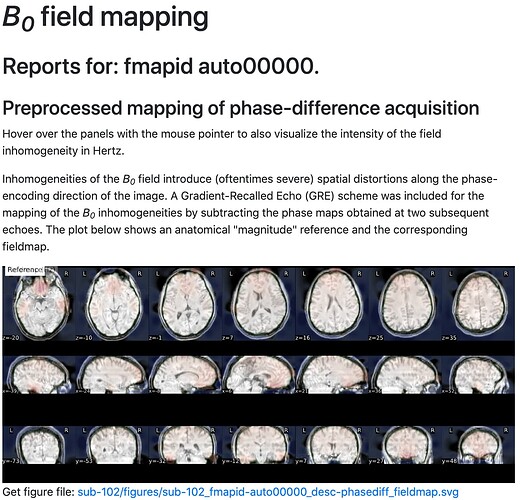Summary of what happened:
I have one magnitude and one phasediff image. The images appear to be detected but are not applied to the EPI images (error in unwarp_wf). I’ve referenced these images in the “IntendedFor” field in both the magnitude and phasediff JSON files. My understanding is that no further fields need to be added with the newer versions of fMRIPREP.
Any advice on how to get unwarping of the EPI images to work?
Command used (and if a helper script was used, a link to the helper script or the command generated):
singularity run --cleanenv /u/project/CCN/apps/fmriprep/rh7/23.1.3/23.1.3-fmriprep.sif /u/project/data/mri/crave/BIDS /u/project/data/mri/crave/BIDS/derivatives --skip_bids_validation --fs-subjects-dir /u/project/data/mri/crave/BIDS/derivatives/freesurfer --participant_label sub-102 -t label -w /u/project/data/mri/crave/tmp_fmriprep --output-spaces MNI152NLin2009cAsym func --nthreads 4 --omp-nthreads 4 --mem-mb 32000 --fs-license-file /u/project/CCN/apps/freesurfer/rh7/7.1.1/license.txt participant
Version:
fMRIPrep-23.1.4
Environment (Docker, Singularity / Apptainer, custom installation):
Singularity
Data formatted according to a validatable standard? Please provide the output of the validator:
bids_validate.py
Relevant log outputs (up to 20 lines):
[Node] Setting-up "fmriprep_23_1_wf.single_subject_102_wf.func_preproc_task_label_run_1_wf.unwarp_wf.rotime" in "/u/project/data/mri/crave/tmp_fmriprep/fmriprep_23_1_wf/single_subject_102_wf/func_preproc_task_label_run_1_wf/unwarp_wf/roti
me".
240529-14:40:24,806 nipype.workflow INFO:
[Node] Executing "rotime" <sdcflows.interfaces.epi.GetReadoutTime>
240529-14:40:24,816 nipype.workflow INFO:
[Node] Finished "rotime", elapsed time 0.009167s.
240529-14:40:24,816 nipype.workflow WARNING:
Storing result file without outputs
240529-14:40:24,819 nipype.workflow WARNING:
[Node] Error on "fmriprep_23_1_wf.single_subject_102_wf.func_preproc_task_label_run_1_wf.unwarp_wf.rotime" (/u/project/data/mri/crave/tmp_fmriprep/fmriprep_23_1_wf/single_subject_102_wf/func_preproc_task_label_run_1_wf/unwarp_wf/rotime)
240529-14:40:25,620 nipype.workflow INFO:
[Node] Finished "bold_split", elapsed time 5.101312s.
240529-14:40:26,352 nipype.workflow ERROR:
Node rotime failed to run on host n1965.
240529-14:40:26,641 nipype.workflow ERROR:
Saving crash info to /u/project/data/mri/crave/BIDS/derivatives/sub-102/log/20240529-143518_5188c716-c2a9
-49bc-a0b4-c3ed4d547952/crash-20240529-144026-darag-rotime-d1e1f7d8-d1e2-4717-b48d-5d416a0d5d9e.txt
Traceback (most recent call last):
File "/opt/conda/envs/fmriprep/lib/python3.10/site-packages/nipype/pipeline/plugins/multiproc.py", line 67, in run_node
result["result"] = node.run(updatehash=updatehash)
File "/opt/conda/envs/fmriprep/lib/python3.10/site-packages/nipype/pipeline/engine/nodes.py", line 527, in run
result = self._run_interface(execute=True)
File "/opt/conda/envs/fmriprep/lib/python3.10/site-packages/nipype/pipeline/engine/nodes.py", line 645, in _run_interface
return self._run_command(execute)
File "/opt/conda/envs/fmriprep/lib/python3.10/site-packages/nipype/pipeline/engine/nodes.py", line 771, in _run_command
raise NodeExecutionError(msg)
nipype.pipeline.engine.nodes.NodeExecutionError: Exception raised while executing Node rotime.
Traceback:
Traceback (most recent call last):
File "/opt/conda/envs/fmriprep/lib/python3.10/site-packages/nipype/interfaces/base/core.py", line 397, in run
runtime = self._run_interface(runtime)
File "/opt/conda/envs/fmriprep/lib/python3.10/site-packages/sdcflows/interfaces/epi.py", line 57, in _run_interface
self._results["readout_time"] = get_trt(
File "/opt/conda/envs/fmriprep/lib/python3.10/site-packages/sdcflows/utils/epimanip.py", line 228, in get_trt
raise ValueError("Unknown total-readout time specification")
ValueError: Unknown total-readout time specification
